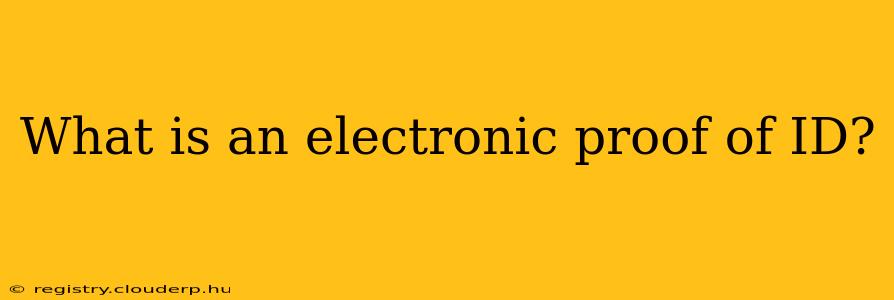In today's increasingly digital world, the need for secure and convenient identity verification has led to the rise of electronic proofs of ID, also known as eID. But what exactly is an electronic proof of ID? Simply put, it's a digital version of a government-issued identification document, like a driver's license or passport, that can be used to verify your identity online or in person using a suitable device. Unlike physical IDs, eIDs offer enhanced security features and streamlined verification processes, making them a valuable tool for various applications.
What are the different types of electronic proof of ID?
Several forms of electronic proof of ID exist, each with its unique characteristics and security measures. These can range from simple digital images of your ID to more sophisticated systems involving biometric verification.
-
Digital Images: While not a true eID in the strictest sense, simply having a high-quality digital photograph of your ID can sometimes suffice for basic verification. However, this method is highly vulnerable to fraud and should only be used when minimal security is required.
-
Mobile Driver's Licenses (mDLs): These are digitally issued driver's licenses stored on a smartphone or other mobile device. They often incorporate security features like QR codes or digital signatures to prevent tampering. Functionality varies depending on the issuing state or jurisdiction.
-
National eID cards: Many countries are issuing national electronic identity cards that contain a chip with biometric data and other information. These cards provide a high level of security and can be used for a wide range of purposes, from voting to accessing government services.
-
Software-based eIDs: Some systems use software to verify identities through various methods, such as connecting to government databases or utilizing strong authentication protocols. This approach can be highly secure and flexible, particularly useful for online interactions.
How secure are electronic proofs of ID?
The security of an electronic proof of ID depends heavily on the specific technology employed. Many modern eID systems incorporate advanced security measures such as:
- Biometric authentication: Using fingerprints, facial recognition, or other biometric data to verify the user's identity.
- Digital signatures: Cryptographic techniques to ensure the integrity and authenticity of the eID.
- Encryption: Protecting the data stored on the eID from unauthorized access.
- Multi-factor authentication: Requiring multiple methods of verification, like a password and a biometric scan, for increased security.
However, no system is impenetrable. Sophisticated attacks remain a possibility, making ongoing updates and improvements to security protocols crucial.
What are the benefits of using electronic proofs of ID?
Electronic proofs of ID offer several advantages over their physical counterparts:
- Convenience: Easy access to your ID anytime, anywhere, from your smartphone or other device.
- Increased security: Advanced security features help to prevent fraud and identity theft.
- Streamlined processes: Faster and more efficient identity verification for various applications.
- Environmental benefits: Reduced paper usage and printing costs.
- Accessibility: Can be more accessible to individuals with disabilities or those who have difficulty carrying physical documents.
What are the risks of using electronic proofs of ID?
While eIDs offer significant advantages, potential risks need consideration:
- Data breaches: The risk of unauthorized access to personal data stored on the eID, albeit minimized by robust security measures.
- Privacy concerns: The potential for misuse of personal information collected during identity verification.
- Technical issues: Reliance on technology means potential difficulties due to software glitches, device malfunctions, or lack of internet access.
- Dependence on technology: The need for a smartphone or compatible device to access and use the eID.
How can I get an electronic proof of ID?
The process for obtaining an eID varies significantly depending on your location and the specific type of eID. Some jurisdictions offer mDLs directly through their motor vehicle departments. Others may require applying for a national eID card through government channels. Check with your local or national government websites for specific instructions.
What information is typically included on an electronic proof of ID?
Information included on an eID usually mirrors that found on physical IDs, such as:
- Full legal name
- Date of birth
- Address
- Photograph
- Unique identification number
- Possibly biometric data (e.g., fingerprints, facial scan)
The exact information varies based on the issuing authority and the specific type of eID. It is vital to understand exactly what data is being collected and stored.
Electronic proofs of ID are transforming how we prove our identity in the digital age. While challenges and risks remain, their benefits in terms of convenience, security, and efficiency are undeniable. As technology continues to advance, we can expect eIDs to play an increasingly important role in our daily lives.

